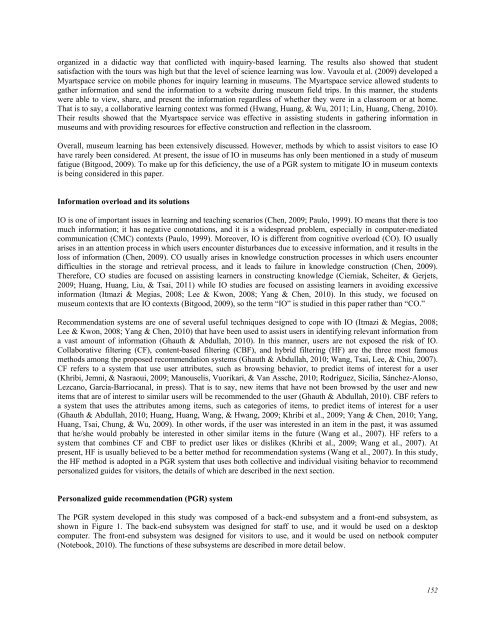October 2012 Volume 15 Number 4 - Educational Technology ...
October 2012 Volume 15 Number 4 - Educational Technology ...
October 2012 Volume 15 Number 4 - Educational Technology ...
Create successful ePaper yourself
Turn your PDF publications into a flip-book with our unique Google optimized e-Paper software.
organized in a didactic way that conflicted with inquiry-based learning. The results also showed that student<br />
satisfaction with the tours was high but that the level of science learning was low. Vavoula et al. (2009) developed a<br />
Myartspace service on mobile phones for inquiry learning in museums. The Myartspace service allowed students to<br />
gather information and send the information to a website during museum field trips. In this manner, the students<br />
were able to view, share, and present the information regardless of whether they were in a classroom or at home.<br />
That is to say, a collaborative learning context was formed (Hwang, Huang, & Wu, 2011; Lin, Huang, Cheng, 2010).<br />
Their results showed that the Myartspace service was effective in assisting students in gathering information in<br />
museums and with providing resources for effective construction and reflection in the classroom.<br />
Overall, museum learning has been extensively discussed. However, methods by which to assist visitors to ease IO<br />
have rarely been considered. At present, the issue of IO in museums has only been mentioned in a study of museum<br />
fatigue (Bitgood, 2009). To make up for this deficiency, the use of a PGR system to mitigate IO in museum contexts<br />
is being considered in this paper.<br />
Information overload and its solutions<br />
IO is one of important issues in learning and teaching scenarios (Chen, 2009; Paulo, 1999). IO means that there is too<br />
much information; it has negative connotations, and it is a widespread problem, especially in computer-mediated<br />
communication (CMC) contexts (Paulo, 1999). Moreover, IO is different from cognitive overload (CO). IO usually<br />
arises in an attention process in which users encounter disturbances due to excessive information, and it results in the<br />
loss of information (Chen, 2009). CO usually arises in knowledge construction processes in which users encounter<br />
difficulties in the storage and retrieval process, and it leads to failure in knowledge construction (Chen, 2009).<br />
Therefore, CO studies are focused on assisting learners in constructing knowledge (Cierniak, Scheiter, & Gerjets,<br />
2009; Huang, Huang, Liu, & Tsai, 2011) while IO studies are focused on assisting learners in avoiding excessive<br />
information (Itmazi & Megias, 2008; Lee & Kwon, 2008; Yang & Chen, 2010). In this study, we focused on<br />
museum contexts that are IO contexts (Bitgood, 2009), so the term “IO” is studied in this paper rather than “CO.”<br />
Recommendation systems are one of several useful techniques designed to cope with IO (Itmazi & Megias, 2008;<br />
Lee & Kwon, 2008; Yang & Chen, 2010) that have been used to assist users in identifying relevant information from<br />
a vast amount of information (Ghauth & Abdullah, 2010). In this manner, users are not exposed the risk of IO.<br />
Collaborative filtering (CF), content-based filtering (CBF), and hybrid filtering (HF) are the three most famous<br />
methods among the proposed recommendation systems (Ghauth & Abdullah, 2010; Wang, Tsai, Lee, & Chiu, 2007).<br />
CF refers to a system that use user attributes, such as browsing behavior, to predict items of interest for a user<br />
(Khribi, Jemni, & Nasraoui, 2009; Manouselis, Vuorikari, & Van Assche, 2010; Rodríguez, Sicilia, Sánchez-Alonso,<br />
Lezcano, García-Barriocanal, in press). That is to say, new items that have not been browsed by the user and new<br />
items that are of interest to similar users will be recommended to the user (Ghauth & Abdullah, 2010). CBF refers to<br />
a system that uses the attributes among items, such as categories of items, to predict items of interest for a user<br />
(Ghauth & Abdullah, 2010; Huang, Huang, Wang, & Hwang, 2009; Khribi et al., 2009; Yang & Chen, 2010; Yang,<br />
Huang, Tsai, Chung, & Wu, 2009). In other words, if the user was interested in an item in the past, it was assumed<br />
that he/she would probably be interested in other similar items in the future (Wang et al., 2007). HF refers to a<br />
system that combines CF and CBF to predict user likes or dislikes (Khribi et al., 2009; Wang et al., 2007). At<br />
present, HF is usually believed to be a better method for recommendation systems (Wang et al., 2007). In this study,<br />
the HF method is adopted in a PGR system that uses both collective and individual visiting behavior to recommend<br />
personalized guides for visitors, the details of which are described in the next section.<br />
Personalized guide recommendation (PGR) system<br />
The PGR system developed in this study was composed of a back-end subsystem and a front-end subsystem, as<br />
shown in Figure 1. The back-end subsystem was designed for staff to use, and it would be used on a desktop<br />
computer. The front-end subsystem was designed for visitors to use, and it would be used on netbook computer<br />
(Notebook, 2010). The functions of these subsystems are described in more detail below.<br />
<strong>15</strong>2

















